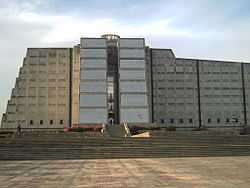Columbus Lighthouse
| The Columbus Lighthouse (Faro a Colón) | |
|---|---|
|
The Columbus Lighthouse | |
 Location in Dominican Republic | |
| Established | 1992 |
| Location |
Santo Domingo Este |
| Coordinates | 18°28′43″N 69°52′05″W / 18.47861°N 69.86816°W |
| Type | Mausoleum, Museum |
Columbus Lighthouse (Spanish: Faro a Colón) is a monument located in Santo Domingo Este, Dominican Republic, in tribute to Christopher Columbus.
Construction began in 1986 using plans drawn by Scottish architect J.L. Gleave in 1931, in time for the 500th anniversary of the Discovery of America, the monument was inaugurated in 1992. It was funded by the Latin American states[1][2] and the total cost of construction was approximately US$70 million.[3]
The monument's lighthouse-style features projecting beams of light, forming a cross shape, which are so powerful they can be seen from neighboring Puerto Rico.[3]
Containing what are purported to be the remains of Columbus, the monument is both a mausoleum and a museum showcasing objects including a boat from Cuba and Columbian jewelry. Constructed of concrete, the monument is 680 feet (210 m) long.[3] Its architecture is cross-shaped and represents the Christianization of America.
Architecture
The Columbus Lighthouse is a cross-shaped monument made of reinforced concrete. Its dimensions are 680 feet (210 m) by 195 feet (59 m). There are 157 beams of light that emanate towards the sky from the structure and a rotating beam, which can be seen for miles.
History
The Dominican historian Antonio Delmonte y Tejada, in his book History of Santo Domingo, published in 1852, expressed the idea of erecting a monument in honor of Columbus in Santo Domingo.[4] In 1914, the American Pulliam William Ellis began selling the idea of building a monumental beacon in the first city of the New World to the American press. The idea becomes universally accepted during the 1923 celebration of the Fifth International Conference in Chile, when it is decreed that this monument should be built in cooperation by all governments and peoples of America.
Scottish architect Joseph Lea Gleave won the competition among 455 participants from 48 countries. The ceremony was held in Brazil in 1931, and the judges included distinguished architects such as Horacio Acosta y Lara (Uruguay), Eliel Saarinen (Finland), and Frank Lloyd Wright (USA).[5] But, by 1950 only eight countries had made contributions totaling less than $15,000, yet the Dominican government forged ahead with the project, and in 1948 the foundations of the monument were inaugurated.[4] After 1948 there was growing instability in the country and the political situation made it impossible to resume construction until 1986. During the government of Joaquín Balaguer, construction resumed under the supervision of the Dominican architect Teófilo Carbonell, and culminating in the construction of the monument in 1992, in time for the celebration of the quincentennial discovery of the Americas.[6]
The monument, though originally conceived by Gleave as a mausoleum, was adapted to house a permanent collection of exhibitions from each American country as well as other European and Asian countries, as requested by former President Balaguer.
References
- ↑ "Où est donc enterré Christophe Colomb ?" Cristobal-colon.net. Retrieved June 4, 2009
- ↑ Le phare de Christophe Colomb Entre2voyages.com Retrieved June 4, 2009
- ↑ 3.0 3.1 3.2 Jacobs, Karrie (April 2010), "World's Strangest Buildings", Travel + Leisure, retrieved 2010-04-25
- ↑ 4.0 4.1 "Faro a Colon". Indiana.edu. Retrieved 27 April 2011.
- ↑ http://www.glj.com.do/home.php/biblioteca_virtual/arquitectura_dominicana
- ↑ "Columbus Lighthouse". NewYorkTimes.com. Retrieved 27 April 2011.
External links
Coordinates: 18°28′43″N 69°52′05″W / 18.47861°N 69.86816°W
